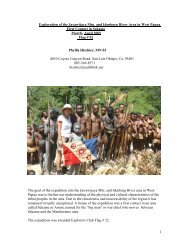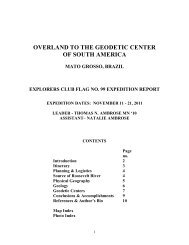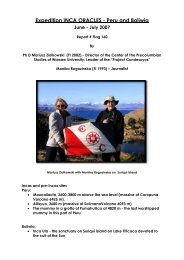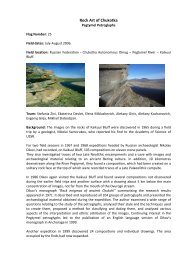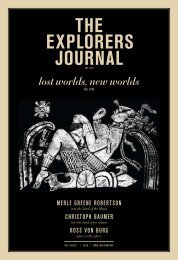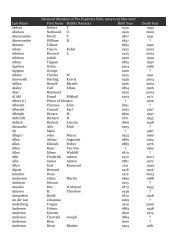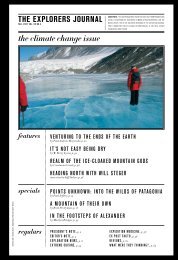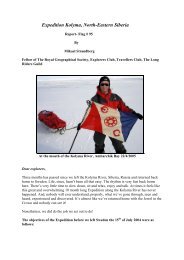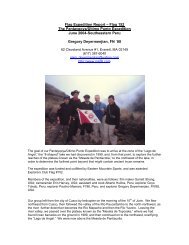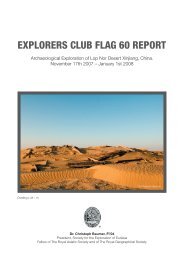the explorers journal - The Explorers Club
the explorers journal - The Explorers Club
the explorers journal - The Explorers Club
Create successful ePaper yourself
Turn your PDF publications into a flip-book with our unique Google optimized e-Paper software.
Karakoram Range, K2 is so remote<br />
it is not visible even from<br />
<strong>the</strong> nearest village. Since its<br />
discovery in 1856 by a survey<br />
team, its height and difficulty<br />
have lured <strong>the</strong> best and bravest<br />
of mountaineers, including<br />
Ed Viesturs, <strong>the</strong> first American<br />
to summit all fourteen of <strong>the</strong><br />
world’s 8,000-meter peaks<br />
and author of <strong>the</strong> recently released,<br />
K2, Life and Death on<br />
<strong>the</strong> World’s Most Dangerous<br />
Mountain. Viestures picked six<br />
K2 expeditions, (1938, 1939,<br />
1953, 1954, 1986, and 2008)<br />
to lay bare <strong>the</strong> “story behind<br />
<strong>the</strong> story” in order to explore<br />
<strong>the</strong> basic tenets of mountaineering:<br />
“risk, ambition, loyalty<br />
to one’s teammates, self-sacrifice,<br />
and <strong>the</strong> price of glory.”<br />
He begins his story in<br />
August 2008, when several<br />
international expeditions were<br />
poised for <strong>the</strong> final slog to K2’s<br />
summit. Echoing <strong>the</strong> Everest<br />
disaster of 1996, things began<br />
to go wrong early on—a<br />
late start by oxygen-deprived<br />
climbers; a pile-up at a narrow<br />
“bottleneck,” where everyone<br />
waits <strong>the</strong>ir turn; bad wea<strong>the</strong>r<br />
moving in; and <strong>the</strong> usual problems<br />
of miscommunication.<br />
When <strong>the</strong> climbers reached<br />
<strong>the</strong>ir prescribed turnaround<br />
time, many were still waiting to<br />
ascend. <strong>The</strong>n disaster struck.<br />
An enormous serac (suspended<br />
glacier) hanging above <strong>the</strong><br />
bottleneck, which had been<br />
stable for decades, calved,<br />
roaring down <strong>the</strong> mountain<br />
and cascading down on <strong>the</strong><br />
climbers.<br />
Veisturs recounts <strong>the</strong> events<br />
of that climb and helps us understand<br />
that <strong>the</strong>re was no one<br />
event that claimed 11 lives. He<br />
60<br />
REVIEWS<br />
also looks at his own experience<br />
climbing K2 and honestly<br />
recounts events that his previous<br />
book, No Shortcuts to <strong>the</strong><br />
Top, glossed over. <strong>The</strong> book is<br />
packed with little-known acts<br />
of incredible heroism, stupidity,<br />
selfishness, profound<br />
friendship, bitter life-long enmity,<br />
feats of daring, amazing<br />
rescues, and horrific loss. He<br />
says he wanted to “imagine my<br />
way into <strong>the</strong>ir company, where<br />
I can ponder <strong>the</strong> what-mighthave-been<br />
of <strong>the</strong>ir dilemmas.”<br />
In addition to being a great<br />
read, <strong>the</strong> book examines <strong>the</strong><br />
hubris we all carry with us and<br />
how we come to terms with it.<br />
N o t e b o o k s f r o m<br />
N e w G u i n e a<br />
by Vojtech Novotny<br />
256 pp • Oxford: Oxford University<br />
Press, 2009 • ISBN-10: 0199561656, ISBN-<br />
13: 978-0199561650 • $34.95<br />
When field ecologist Vojtech<br />
Novotny, a professor of ecology<br />
at <strong>the</strong> Czech Academy<br />
of Sciences, settled in New<br />
Guinea to study tropical<br />
forests, he had no idea what<br />
<strong>the</strong> foray would bring over<br />
<strong>the</strong> course of a decade. For<br />
in addition to <strong>the</strong> region’s<br />
extraordinary environmental<br />
diversity, he found abundant<br />
culturaldiversity with distinct<br />
groups speaking more than<br />
1,000 languages. His experiences<br />
<strong>the</strong>re are recorded in<br />
Notebooks from New Guinea,<br />
a charming and insightful, if<br />
unusual, riff on <strong>the</strong> world he<br />
encounters.<br />
Soon after his arrival,<br />
Novotny finds that magic and<br />
spirits permeate local belief<br />
systems, which impact his<br />
own work. He finds he has to<br />
move his entomological lab<br />
because <strong>the</strong> swamp where it<br />
was built sat atop a masalai<br />
(spirit), which was believed to<br />
be causing sickness in <strong>the</strong> lab.<br />
When discussing cannibalism,<br />
he tells us “one might argue on<br />
humanitarian grounds against<br />
ideologies that view neighbors<br />
as canned meat on two legs,<br />
(but) eating <strong>the</strong> deceased<br />
was actually a highly civilized<br />
custom.” Novotny is interested<br />
in <strong>the</strong> edges of populations,<br />
where he says <strong>the</strong> most<br />
change is occurring. Whe<strong>the</strong>r<br />
speaking of plants, insects,<br />
or people, he talks about a<br />
landscape that is in constant<br />
flux as volcanoes bury and<br />
tsunamis wash away villages,<br />
rivers change course, and mining<br />
companies strip <strong>the</strong> land.<br />
What Novotny discovered is a<br />
people with a profound sense<br />
of place who have a deep<br />
understanding of <strong>the</strong>ir natural<br />
environment, which is being<br />
crunched by “<strong>the</strong> big yellow<br />
tractor.” His book is a delight,<br />
an ode to a unique part of <strong>the</strong><br />
world.



